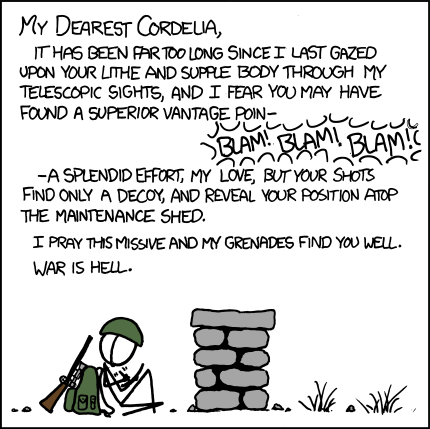Sunday, April 17, 2011
Reflection: The Yellow Wallpaper
Charlotte Gilman's "The Yellow Wallpaper" is a story about a woman's confinement and her journey to get better from her temporary nervous depression. In the beginning it was rather confusing to understand because the story was written in a journal entry format. The narrator mentions names and events that I don't exactly recall, so I usually assume that this or that happened. But later on the story was easier to understand as the woman became more psychotic. Throughout the story I became angry at the doctor husband. He treated the narrator more like a patient than a wife, and he seemed to convince her that he knew what was best for her simply because he was the doctor. It was frustrating to see how her train of thought changed because of John. She would write about what she thought about herself, then what John told her about her condition, then she would change her mind about herself, making it seem like John is always right about his diagnoses. I think that Gilman's writing style helps her message (that resting will not cure her condition) get across to the audience. The story is written in first person, so the audience reads the story as if he/she is the one going mad in the room and imagining the woman behind the wallpaper. The journal entry style shows us step by step how the woman's mental condition progressively changed over time since it is told in her perspective.
Monday, April 11, 2011
Reflection: Waltz with Bashir (2008)
The scene from 28:00 to 29:00 starts with a line of tanks peacefully driving and the narrator saying, "When you are inside the tank you always feel completely safe. The tank is a gigantic enclosed vehicle, inside the tank it will protect it." It follows with one tank crushing a bunch of parked cars and ends with the camera angle following the bullet that kills the commander.
This particular scene stood out to me because of how little narration was involved and how much detail there was with the art. When the tank starts running over the cars and the narrator says his one line, the scene is in the perspective from inside the large tank. The audience expects the tank to be indestructible and the people inside of it to be immortal. The cheerful music makes the scene almost happy and somewhat humorous, so nobody expects anything to go wrong. Then all of a sudden, you (the audience) are the bullet accelerating towards the tank. This is where I think animation helps the film get its point across - that anything can happen in a war. You know you're the bullet, you know someone's about to die, yet when it actually happens, you're surprised.
This particular scene stood out to me because of how little narration was involved and how much detail there was with the art. When the tank starts running over the cars and the narrator says his one line, the scene is in the perspective from inside the large tank. The audience expects the tank to be indestructible and the people inside of it to be immortal. The cheerful music makes the scene almost happy and somewhat humorous, so nobody expects anything to go wrong. Then all of a sudden, you (the audience) are the bullet accelerating towards the tank. This is where I think animation helps the film get its point across - that anything can happen in a war. You know you're the bullet, you know someone's about to die, yet when it actually happens, you're surprised.
 |
| xkcd: War |
Subscribe to:
Comments (Atom)